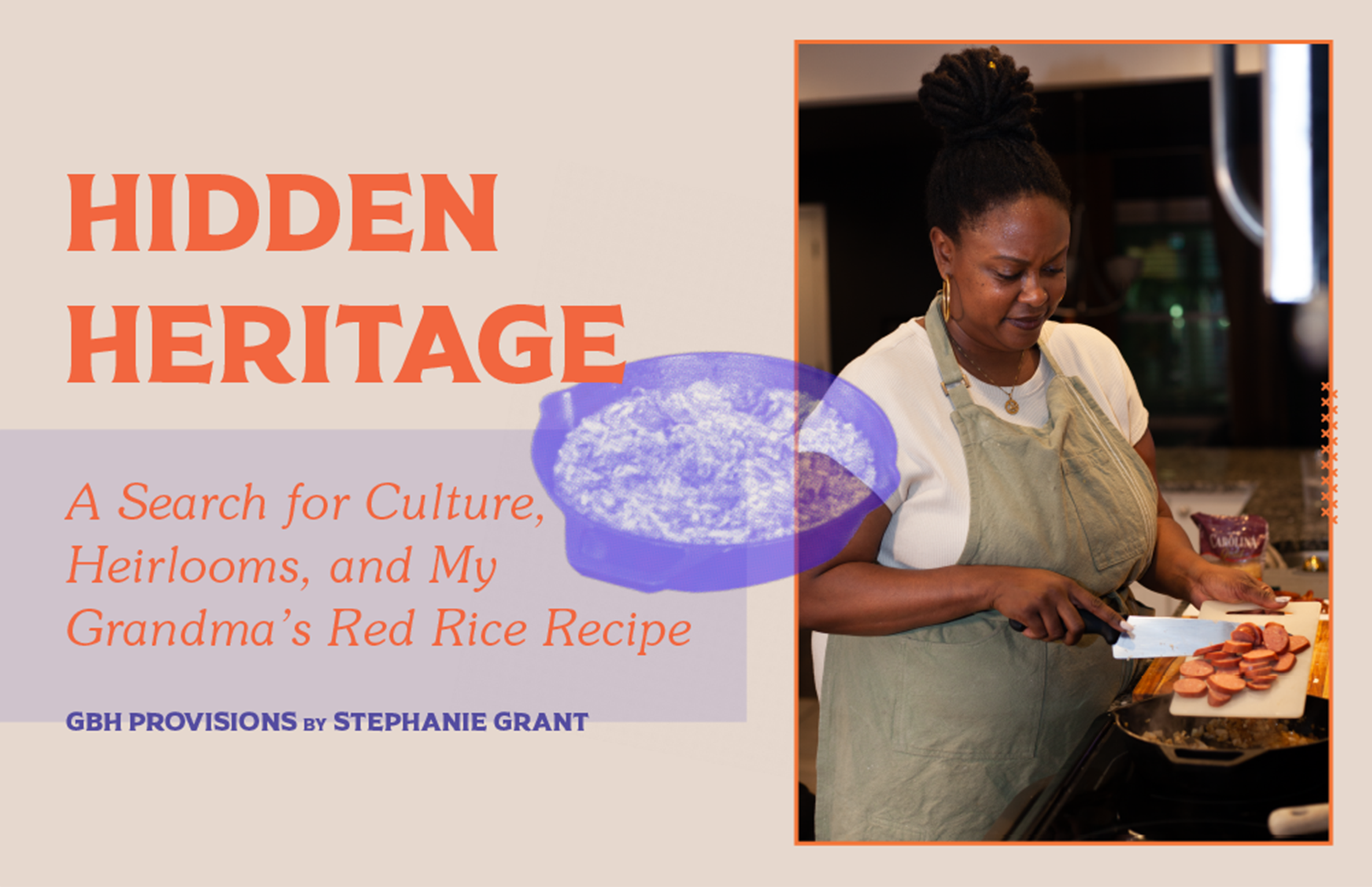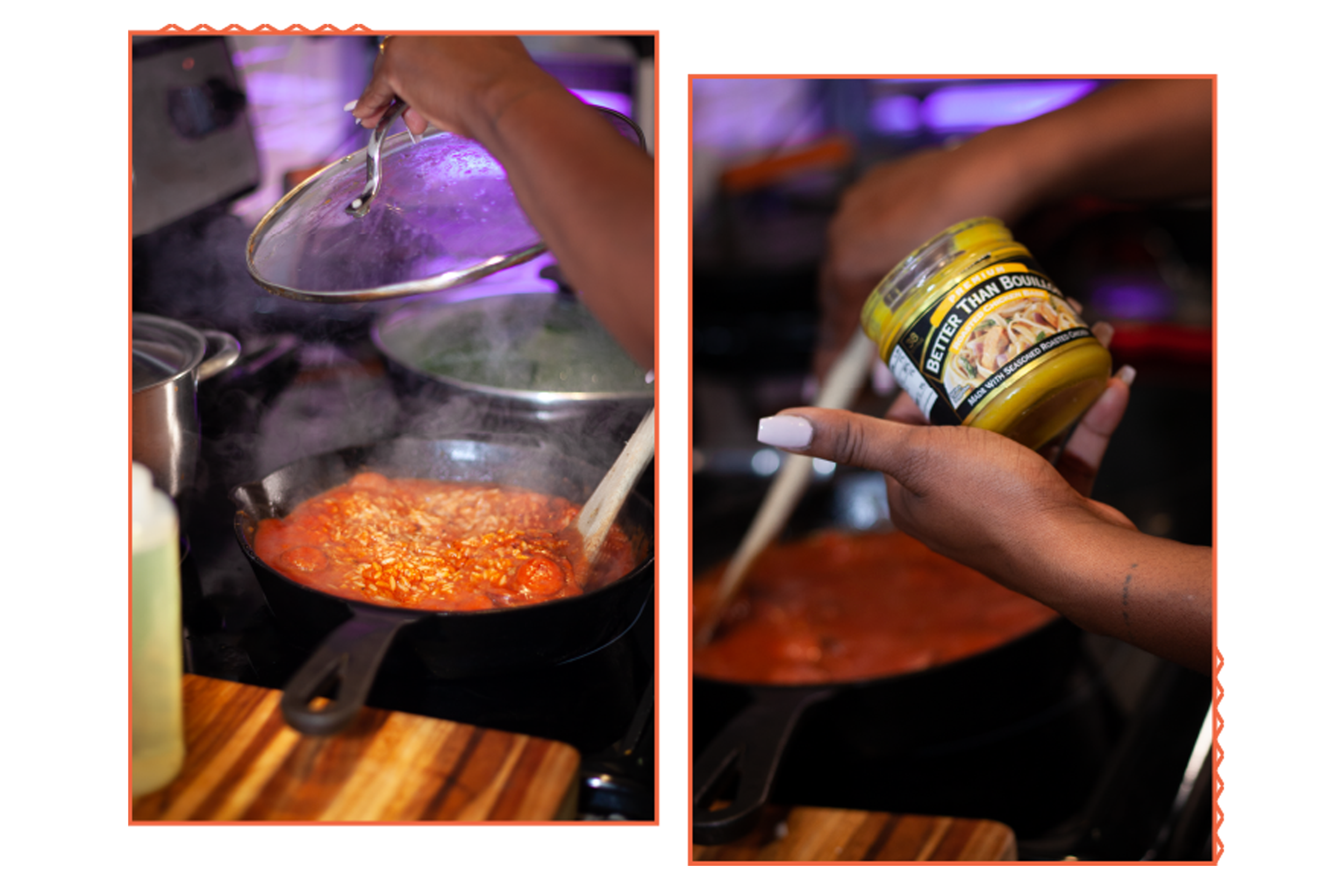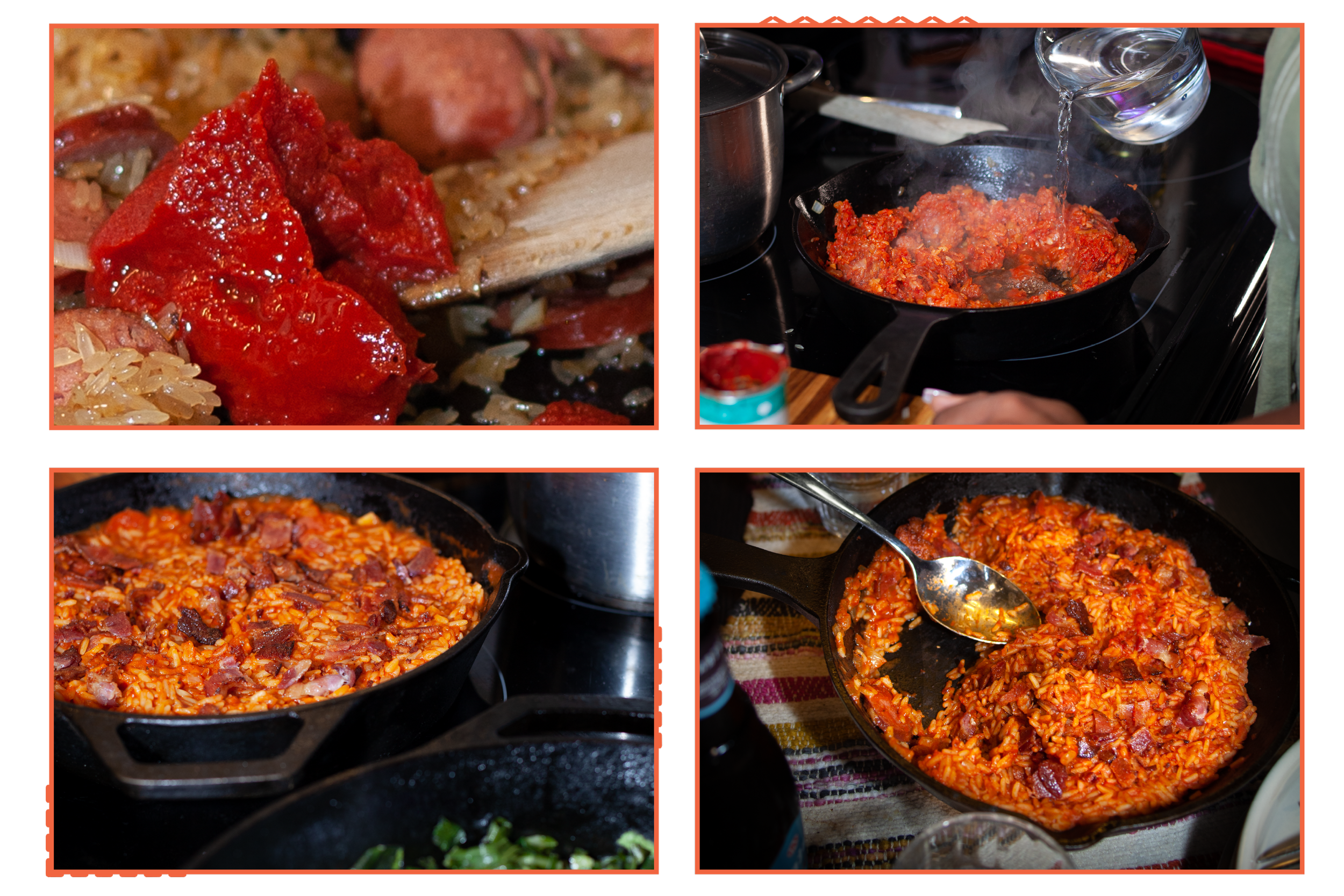In my earliest memory of cooking, I am 7 years old, and in our small galley kitchen in East Point, a city south of Atlanta. I remember that, if you were on the wrong side of the open oven door, you’d get trapped. My mother and I learned to coordinate our movements around the oven, which produced so many irresistible roast chickens and trays of meatloaf, so we didn’t disrupt the flow of cooking.
Once I was old enough to handle sharp objects, she put me to work—grating cheese on a box grater, chopping onions and celery. “No one wants to eat a big hunk of onion,” she would say while sorting through my haphazard pile. It was the first of many culinary lessons she imparted to me.
Under her tutelage, I learned the importance of tasting everything. After taking turns slurping chili off a wooden spoon, our eyes would meet. “What’s missing?” she’d ask, and I would answer: salt, accent, garlic, or chili powder. We would sprinkle in our guess, tasting again to make sure the flavors matched our memories of the last time we ate this dish. Later, she taught me to add one tablespoon of vanilla despite what the recipe said, to season meat in advance, and to always wash your greens—collards, turnips, or mustards—at least three times.
But like the best chefs, I didn’t have just one teacher. From my best friend’s mom, Laucenia Frasier, I learned the importance of asking for help. Whenever I visited her in South Georgia, it seemed there was always a reason to celebrate, which meant we needed to feed a crowd. While we bumped around in the kitchen dicing, stirring, and boiling, people came by throughout the day, dropping off cakes and pies and other foil-wrapped dishes. We had some grand celebrations at her house.
And from my Grandma Inez, I learned that food is a love language. No matter when we pulled onto Ashe Street in downtown Charleston—even if it was in the middle of the night—Grandma was more than happy to greet us with a hot meal.
We would make ourselves comfortable at the table, or on the plastic-covered couch. Grandma Inez had an open-plan living space before it was popular, so we could sit back and watch her work. I still remember her standing in the kitchen, her back to us, while she managed the various pots on the stove. She always had a pot of fluffy white rice on the stove because—breakfast, lunch, or dinner—you can’t have a meal without it.
White rice is fine, but my favorite was her red rice, enveloped in rich, browned tomato paste. The browning transformed the flavor from raw and acidic to one with savory depth and sweetness. A perfect bite combined the rice with a bit of salty pork sausage, each grain fluffy, separate, and never mushy. It was the dish that differentiated our table from others: We weren’t just Southern, but we were Gullah-Geechee.
Some families pass down beautiful heirlooms with rich origin stories to accompany them. Large wooden chests, ornate necklaces, antiques. My family doesn’t have much to pass on. The trinkets I have in my collection are valuable because they once belonged to someone I loved.
I used to watch “Antiques Roadshow,” wishing I had an attic to root around in for buried treasure. What a joy it would be to emerge from a dark, cramped space, covered in sweat and cobwebs, with a piece of furniture that would financially change our lives. The dreams of a poor young Black girl.
Growing up, I felt disconnected from my culture. From kindergarten to eighth grade, I attended a Catholic school that was so small it had just one hallway. During Black History Month one year, the administration decided we should celebrate all cultures instead. And while I was lucky to learn from my classmates and their parents about their Nigerian, Ecuadorian, Irish, and Italian cultures, I remember feeling slighted. I didn’t have the words for it then, nor the understanding I do now, but I still knew it was wrong. That wrongness accompanied a longing to better understand my culture, to know my history. The longing to know who I am. Who are my people? What from my past is present now? Is there any connection to the continent?
That longing grew into the desire to honor my ancestors. And as I got older, I realized that my family did have heirlooms—they were just intangible, given to me at an early age while I was attached to my mom’s hip as she cooked dinner. And they had history, as all heirlooms should. Others denigrated the food we ate as fried, greasy, unhealthy, but I later came to realize that those words reflected their limited understanding of Southern (and especially Gullah-Geechee) cooking, which dated back centuries and whose origins stretched across oceans.
Gullah-Geechee foodways combine West African flavors with Native American cooking styles. Our food is rooted in freshness and seasonality, supplied directly from the land and sea—whether it’s just-caught crab and oysters or beans and okra picked from the garden. Rice is central to Gullah-Geechee cuisine, and our ancestors were enslaved and brought from Africa to the Carolinas in part for their expertise in growing rice.
I have found joy in the foodways of my ancestors, and learning about them has bridged the gap between my current reality and their past. Recently, while watching Netflix’s “High on the Hog: How African American Cuisine Transformed America,” I discovered that the red rice I ate at my grandma’s house was a distant cousin of jollof, a popular dish served south of the Sahara and along the coast of West Africa, consisting of rice stewed in a tomato broth with several spices, vegetables, and sometimes meat.
I imagine enslaved Africans reaching the shores of the Carolinas, reeling from the long voyage, trying to find some stability or comforts of home in this hostile new land. Under these new, horrifying conditions of life. They sowed seeds in their hair, bringing familiar ingredients and comforts of home with them. That home became a distant memory, but the taste of jollof rice never really left them. Using what they had on hand, jollof rice became red rice.
But even as I learned more about my Gullah-Geechee heritage, I was losing my hold on those recipes—the family heirlooms—that had been passed down to me. I had just one index card inscribed with my grandma’s slanted script, revealing the secrets to one of my favorite desserts—Swedish apple pie. But there were no index cards for most of her other recipes, and none at all for her red rice.
In 2010, my family packed into our sedan to visit my grandmother, who was no longer on Ashe Street but in a nursing home.
I had only known my grandmother to live in one place, and it was strange walking into that unfamiliar space. We made our way through the corridors of the facility to her room. Instead of the joyous greeting I expected from her, she seemed quiet and distant. I sat across from her, with my dad next to me. We tried to spark up a conversation. I remember asking her about her red rice recipe. I tried to guide her through the conversation with the little things I remembered. But like my fading memories of our time in the kitchen, hers were also hard to grasp. I had been counting on her memory to fill in my childhood blanks, but as she spoke I realized she had momentarily slipped back into another time, another conversation, because the words that came out had nothing to do with my query.
I left that day feeling defeated, unsure that I would ever get her recipe, or taste red rice as I knew it again. For years after, I asked family members and other people who shared my Gullah-Geechee heritage if they had a red rice recipe, and scoured the internet for clues. But I came up empty. We passed a lot of our recipes down while in the kitchen: no measurements, just feeling and tasting. Cooking from the soul. That and the general suppression of Black culture put distance between me and the recipe.
In the absence of that information, I searched my memory for clues, hoping I could uncover those lost components. Even now, I can’t quite get the picture right. I remember feeling the heat of my grandma’s body as her hand guided mine, as we swirled tomato paste in my mom’s cast iron skillet. But the steps after that remain in the past.
Three years ago, on my birthday, when everyone was still embracing the new decade, I was focused on making one wish come true. I slipped into a local bookstore, searching the shelves for the white hardback book. Gold letters graced the cover with a picture of Black hands holding an antique dish. Shrimp nestled inside it, the bowl filled with an herbaceous sauce.
As soon as I knew of the book’s existence, I knew I needed it in my collection. With the energy of three shots of espresso rushing through my body, I took it up to the counter, paid, and rushed out to show my husband. I finally had Toni Tipton-Martin’s cookbook, “Jubilee: Recipes from Two Centuries of African American Cooking.”
At home, I stood in the kitchen flipping through every recipe to take in the words, photos, and stories about my ancestors. But as I turned pages over and over, I held my breath for one dish in particular. When I got to page 169, I felt tears spring to my eyes. Here it was, after all this time: a recipe for red rice.
Red rice is also known as Savannah Red Rice, Gullah Rice, or Carolina Red Rice, as Tipton-Martin writes. Her recipe didn’t just fill in the gaps in my own family’s recipe—it also shone a light on the many contributions my ancestors made to the foodways of this country, stretching way beyond fried chicken and macaroni and cheese.
For me, red rice is a symbol of perseverance and a connection to a continent I have never stepped foot on. It’s a connection to the Gullah-Geechee culture that I’m continuously learning about. It’s my favorite way of keeping my grandma’s memory alive, and every time I stir tomato paste into my cast iron skillet, I’m transported back to that foggy memory of her hand on mine.
Adapted from Toni Tipton-Martin’s “Jubilee” and Grandma Inez’s recipe
Serves 4
3 slices bacon
1 onion, finely diced
1 clove garlic, minced
1 cup Carolina Gold rice or long-grain white rice*
1 6oz can tomato paste
1 Roger Wood smoked pork sausage link, sliced into coins**
Salt and pepper, to taste
Preheat the oven to 375 degrees F. Put bacon slices in a 9-10-inch cast-iron skillet and transfer to the oven. Leave for 10-15 minutes, or until bacon is cooked through but not yet crispy. Remove the pan from the oven and transfer the bacon to a paper towel. Leave any bacon grease in the skillet.
Transfer the cast-iron skillet to a stove top burner and place over medium heat. (Be careful not to touch the handle with your bare hand, as it will be hot from the oven.) Add the onion and saute until translucent, then add garlic to the pan and cook for 1 minute. Add the sausage coins and saute for 2-3 minutes.
Add the rice and stir until translucent, about 2-3 minutes. Stir in the tomato paste and cook for 2-3 minutes before adding 2 cups of water, plus salt and pepper to taste.
Bring to a boil over high heat and then reduce to low. Cover and simmer for 20-25 minutes. Stir after 10 minutes and be careful not to disturb the rice too much.
Once heat is off, let stand for 5 minutes or more, and fluff with a fork. Each grain should be separate, and never mushy.
Taste and adjust seasoning as desired. Sprinkle bacon pieces on top and serve with a heaping amount of hot sauce.
*I have made this dish many times with long-grain white rice, but after making it with Carolina Gold (not the original rice, but a parboiled version), I don’t want to make it with anything else—it never risks getting mushy.
**Roger Wood sausages are available across the Southeast and East Coast. If you’re unable to find them, purchase from the online store or substitute with another type of country smoked pork sausage.




















